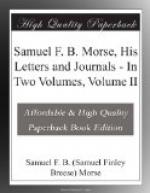Similar invitations were sent to other prominent persons and a very select company gathered at the appointed hour. That the exhibition was a success we learn from the following account in the “Journal of Commerce” of January 29, 1838:—
“THE TELEGRAPH.—We did not witness the operation of Professor Morse’s Electro-Magnetic Telegraph on Wednesday last, but we learn that the numerous company of scientific persons who were present pronounced it entirely successful. Intelligence was instantaneously transmitted through a circuit of TEN MILES, and legibly written on a cylinder at the extremity of the circuit. The great advantages which must result to the public from this invention will warrant an outlay on the part of the Government sufficient to test its practicability as a general means of transmitting intelligence.
“Professor Morse has recently improved on his mode of marking by which he can dispense altogether with the telegraphic dictionary, using letters instead of numbers, and he can transmit ten words per minute, which is more than double the number which can be transmitted by means of the dictionary.”
A charming and rather dramatic incident occurred at this exhibition which was never forgotten by those who witnessed it. General Cummings had just been appointed to a military command, and one of his friends, with this fact evidently in mind, wrote a message on a piece of paper and, without showing it to any one else, handed it to Morse. The assembled company was silent and only the monotonous clicking of the strange instrument was heard as the message was ticked off in the dots and dashes, and then from the other end of the ten miles of wire was read out this sentence pregnant with meaning:—
“Attention, the Universe, by kingdoms right wheel.” The name of the man who indited that message seems not to have been preserved, but, whoever he was, he must have been gifted with prophetic vision, and he must have realized that he was assisting at an occasion which was destined to mark the beginning of a new era in civilization. The attention of the universe was, indeed, before long attracted to this child of Morse’s brain, and kingdom after kingdom wheeled into line, vying with each other in admiration and acceptance.
The message was recorded fourfold by means of a newly invented fountain pen, and was given to General Cummings and preserved by him. It is here reproduced.
[Illustration: “ATTENTION THE UNNIVERSE! BY KINGDOMS RIGHT WHEEL!” Facsimile of the First Morse Alphabet Message, now In the National Museum, Washington]
It will be noticed that the signs for the letters are those, not of the first form of the alphabet as embodied in the drawing attached to the caveat, but of the finally adopted code. This has led some historians, notably Mr. Franklin Leonard Pope, to infer that some mistake has been made in giving out this as a facsimile of this early message; that the letters should have been those of the earlier alphabet. I think, however, that this is but an added proof that Morse devised the first form of the code long before he met Vail, and that the changes to the final form, a description of which I have given, were made by Morse in 1837, or early in 1838, as soon as he became convinced of the superiority of the alphabetic mode, in plenty of time to have been used in this exhibition.




